Sindhi Wedding Rituals

The upbeat vibe and joys of fun, food, drinks and dancing at a Sindhi Wedding Rituals dazzles everyone. But many small and big wedding rituals tucked in a string of love and respect, create a massive significance among India’s rich traditions. Though merriment and fun hold a lion’s share in the Sindhi Wedding, meaningful rituals play an equally important role in this lavish celebration.
The sacred union of two individuals and their families is conducted according to the ancient Vedic rites usually, on the auspicious new moon day or Satyanarayan Chandsi.
To understand the million-worth traditions of a Sindhi wedding closely, you must visit the wedding event once. But for now, this rundown on the entire Sindhi wedding celebration will be enough.
Pre-wedding customaries of a Sindhi Wedding
Kacchi Misri –

Image source: WhatKnot
A formal meeting between both families after fixing the match is called Kacchi Misri in Sindhi wedding culture. The families exchange gifts, clothes, sweets, Mishri (Sugar crystals) and other valuable objects. The bride is adorned with a red cloth piece (chunari) on her head by the sister of the groom, then she placed five fruits on the bride’s lap and offers sweets for an auspicious beginning. The bride’s mother prepares the sacred Kada Prashad for the groom and offers him it on a silver utensil. You can consider this ritual similar to the Roka ceremony in north Indian wedding culture.
Check this also Gujrati Wedding Rituals
Pakki Misri –

Image source: ShaadiWish
Usually, a week or ten days before the big wedding day, the groom’s family arrives at the bride’s place with exquisitely decorated gift hampers. These hampers carry sarees, jewelry, wedding lehenga, gifts, sweets and token money for the bride. The groom’s sister and sister-in-law place these hampers on the lap of the bride and congratulate her on the impending wedding. The groom’s mother fills an earthen pot with Misri and offers it to the bride’s mother. Along with the bride’s mother, a total of seven married women draw the structure of Ganesha Ji on the pot and then the bride’s mother opens it. Under the guidance of a priest, a small puja is organized in which Jhulelal or family deities are invoked. He assesses the horoscopes of the bride and groom and tells them the perfect time or muhurta for the wedding. After that, family members feed each other sweets.
Check this also Sikh Wedding Rituals
Berana Satsang –

Image source: Pinterest
For this unique pre-wedding ritual of a Sindhi wedding, the families hire professional singers who perform devotional singing known as Sindhi Ladas in a group. These prayer songs seek blessings for the couple and their obstacle-free wedding ceremony. The entire family of bride and groom gather separately and sing Sindhi Ladas and congregational prayers for pleasing Jhulelal Ji.
Check this also The Manipuri Wedding Rituals
Dev Bithana or Ganesh Sthapna –

Image source: Trees on the Moon
Five days before the wedding of a couple, a priest or Pujari perform a significant puja at their homes. The priest establishes a grindstone at the home that is considered the Gundro or deity. After Dev Sthapna, the bride and groom can not go out of their homes and their brother and brothers-in-law guard them along with catering to their needs till D-day. These guarding people are known as Anaars.
Check this also Kashmiri Rituals Muslim Wedding
Sagri –

Image source: ShaadiWish
Another bride-centric wedding ritual of Sindhi culture is Sagri in which all the groom’s relatives, friends and family members visit her home with expensive gifts. It is a formal introduction of the bride with every groom’s side member. They shower flower petals on the bride, congratulate her and bless her for the new married phase of life. At this event, the bride wears pompous clothes and eye-catching floral jewelry. Usually, the groom’s sister helps the bride in embellishing her with jewelry and clothes.
Check this also Kashmiri Rituals Hindu Pandit Weddings
Mehendi –

Image source: Pinterest
A day before the wedding, a fun frolic and bride-centric ritual is conducted at the bride’s home. All the females sit around the bride and sing wedding songs. These days peppy Bollywood songs are also played during the mehendi event. The hired professional Mehandi artist fills the palms and hands of the bride with surreal designs. This ritual also takes place at the groom’s home but on a comparatively small scale.
Check this also Wedding rituals in Bihar
Lada or Sangeet Ceremony-

Image source: Lin & Jirsa
After Berana Satsang, Lada or traditional Sindhi wedding songs are sung by the ladies of the groom’s family for more time. All female relatives and neighbors are invited to take part in it. Women beat Thalis and Dhol in a coordinated way to enhance the fun and dance on these traditional folk songs to express their merriment.
Check this also Bengali Wedding Rituals
Tih –

Image source: Bollywood Shaadis
A ceremonial puja is organized at the home of the groom but by the priest of the bride’s side. The bride’s family provides some objects including rice, spices like clove & cardamom, sugar, coconut, sweets (21 pieces), dates(9 pieces) and a big ball of silk green yarn. He performs the puja with all these sacred objects and places a piece of paper on the groom’s lap in which the auspicious time of the wedding or lagna is mentioned.
Check this also Buddhist Wedding Rituals
Head Bukki & Saanth –

Image source: ShaadiWish
Very similar to the Haldi ceremony in north Indian wedding culture, this custom again creates a fun environment at the couple’s house. In the bride’s home, seven married women pour oil on her hair and then smear her face and visible body parts with turmeric paste. It is believed that this ritual adds a wedding glow to the face of the bride.

Image source: WeddingBazaar
On the flip, at the groom’s home, there is a grand fun celebration happen. All the females drench the groom in the oil by heavily pouring it on him and then all loved ones tear the clothes of the groom. This fun-filled ritual signifies that the groom is leaving his single life.
Check this also Nepali Wedding Rituals
Wanwas –

Image source: WedAbout
This ritual happens on the same day of Head Bukki and Saanth when seven married women pour oil over the head and they go for a cleansing bath after it. A priest also reaches the home of the bride and groom separately to perform a puja for the stone grinder deity instilled on the Dev Sthapna ritual day.
Check this also Pagan Wedding Rituals
Jenya –

Image source : Wikipedia
Jenya is a sacred white thread worn by the groom around his upper body. According to the Yajna ritual, the priest performs a religious prayer at the groom’s home. After offering him the sanctified thread recognized as Jenya, the priest whispers a holy Mantra in the groom’s ear. The groom recites this mantra daily during his prayer offering time.
Check this also Chinese Wedding Rituals
Ghari Puja & Navgrahi Puja –
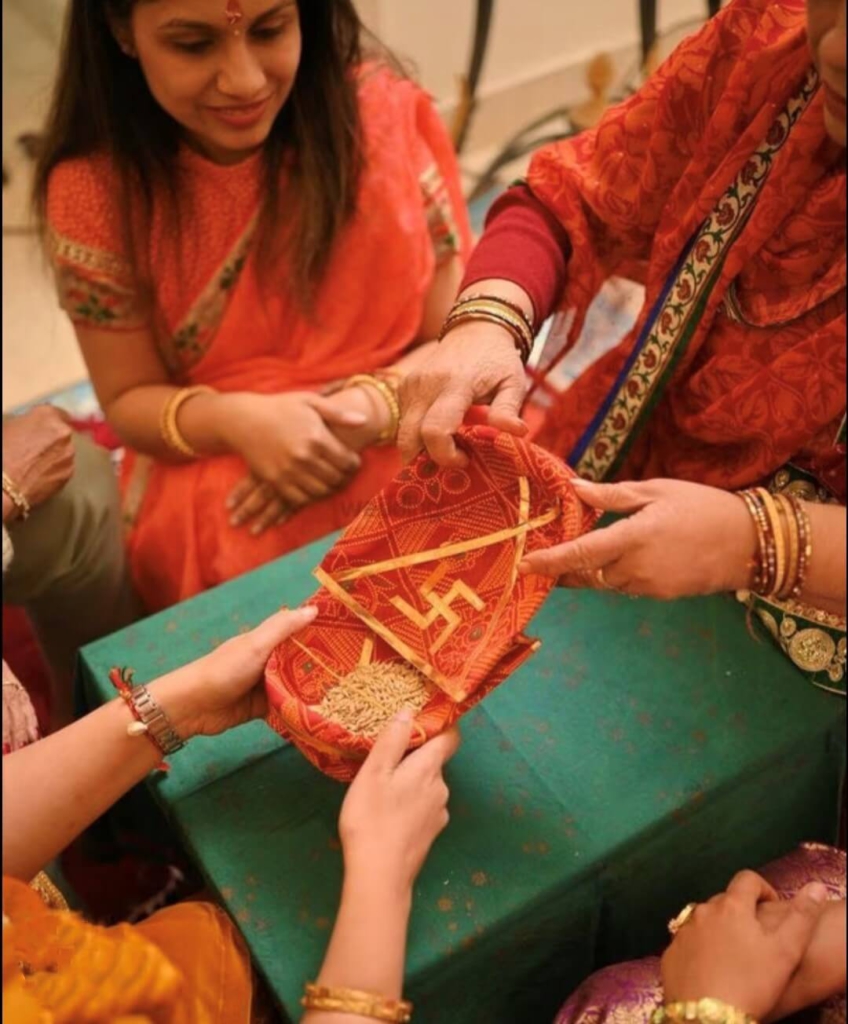
Image source: ShaadiWish
Ghari puja is performed by a priest at the homes of the bride and groom separately. The priest gives a handful of wheat grains to the bride and groom in their homes and then married women grind these wheat grains to make flour of it. This ritual symbolizes the arrival of prosperity in the wedded life of a couple. In the end, both bride and groom smash an earthen lamp with their feet respectively in their homes.

Image source : Pure Prayer
Navgrahi Puja is also performed under the guidance of a priest on the morning of the wedding day. The priest offers prayers to Bhagwan Shiva, Lakshmi, Narayan and Ganesha along with all nine planets of the galaxy. This prayer depicts the way of seeking blessings of deities and requesting all the planets to ward off all obstacles from the auspicious day and time of the wedding. The priest invokes all the cosmic planets by offering them food, water and light to shower blessings on the couple.
Check this also Mormon Wedding Rituals
Kheeram Sat –
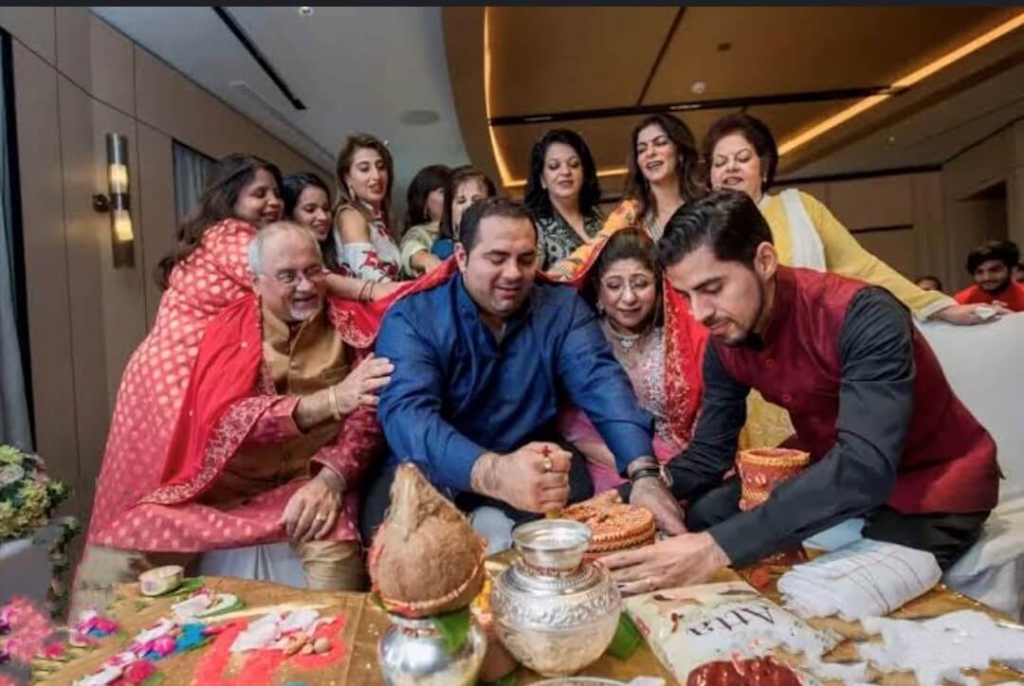
Image source: Event Vogue
On the D – day of couples, the priest presents rice, sugar, raw milk, cardamom, cloves and nutmeg etc to the deities in the temple of the bride and groom’s home separately. These edibles are kept for some time in front of the deities and later the female family members of each home prepare a Prashad by utilizing all of these.
Check this also Korean Wedding Rituals
Measuring the groom –

Image source: CulturalIndia. Net
One of those unique rituals that outshine the Sindhi wedding tradition is measuring the groom with a sacred thread by the sisters-in-law of both sides, bride and groom. One sister-in-law from the groom’s side and two from the bride’s side (each from maternal and paternal family) take part in this ritual. A day before the wedding, these females measure the height of the groom with a thread and tie a knot at a fixed point. Again on the wedding day, they repeat the ritual to ensure that the groom is the same. The females are called Peear Vaari of the groom.
Check this also Jewish Wedding Rituals
The main D-day rituals of a big fat Sindhi Wedding
Garo Dhago –
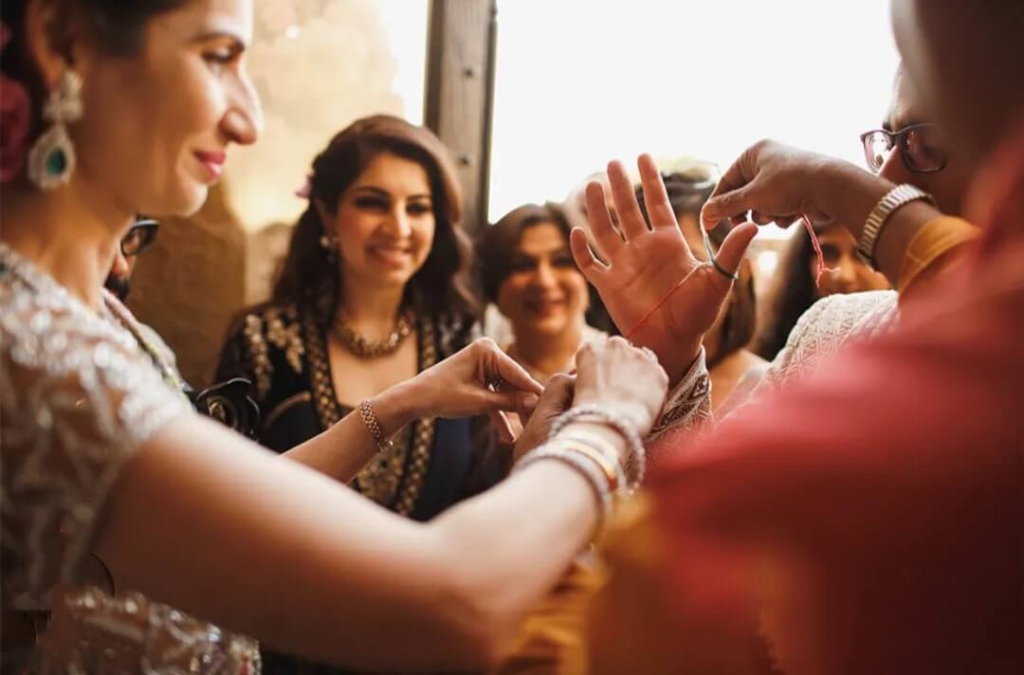
Image source: ShaadiWish
The morning of a Sindhi Wedding is full of a celebration vibe, but the very first ritual that occurs in both homes is evoking the ancestors of the family and pleasing them with a prayer. The priest guides the family and bride/groom in seeking the blessings of their ancestors regarding a successful wedded life. In the end, the priest ties a sacred red thread on the wrists of the bride as well as the groom.
Check this also Iyengar Wedding Rituals
Baraat –

Image source: Happy Wedding App
Now the fully decked up groom sets off from his place and head towards the wedding venue or bride’s place. The groom’s entire procession enjoys the wedding songs and grooves enthusiastically to the beats of Dhol and the wedding Band. Dressed in finery all the members of the groom’s family give a glimpse of pure Sindhi royalty.
Check this also Kerala Wedding Rituals
Swaagat –

Image source: Pinterest
When this boisterous groom’s entourage reaches the wedding venue, everyone receives a grand welcome. First, the mother of the bride performs tilak and aarti of the groom and playfully pulls his nose. Other Baraatis are welcomed with sugar, cardamom and a decent sprinkling of rose water on them. The groom enters the place after breaking an earthen lamp with his feet and Peear Vaari again measures the groom. A dupatta or sheet is also placed to block the view of the groom and bride so that both can not see each other. After performing a customary puja, they are allowed to gaze at each other.
Check this also Kannada Wedding Rituals
Paon Dhulaai –

Image source: ShaadiWish
After entering the sacred wedding mandap, both bride and groom sit beside each other on a beautiful blanket gifted by the bride’s parents. Now the bride’s parents wash the feet of the groom with milk and water and consider their son-in-law as the embodiment of Bhagwan Vishnu.
Check this also Hindu Wedding Rituals
Jaimala –

Image source: News8plus
The bride and groom stand up facing each other and exchange beautiful garlands. In Sindhi wedding culture, the exchange of Garland takes place thrice. In some families, close ones make it difficult to exchange garlands for the bride and groom by lifting them at a good height. A lot of fun and mischief compel the people to giggle.
Check this also Baniya /Agarwal wedding rituals
Palli Pallo –
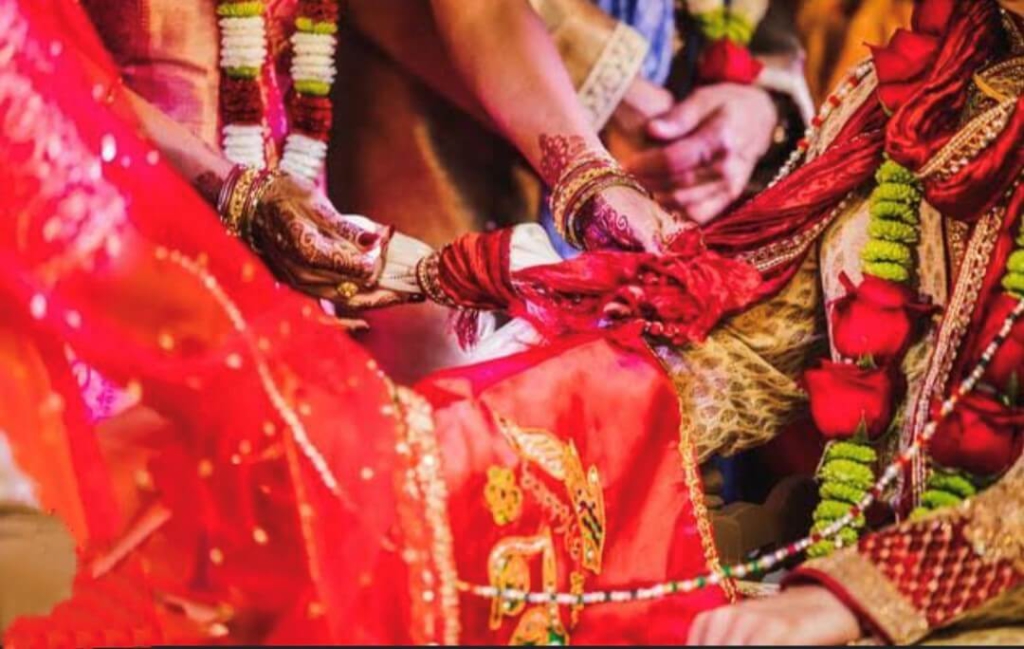
Image source: WeddingWire
The headscarf or dupatta is tied to the corner of the groom’s attire. The sister of the groom ties two knots by placing some rice grains in it.
Hathiyaala or Hathiyaalo –

Image source: ShaadiWish
For this ritual, the right hands of the bride and groom are tied gently with a red cloth. Now they are asked to pray to God together. This shows the union of both individuals for the rest of their life. Usually, the elder person of the family or the priest ties their hands softly with a sacred cloth.
Check this also Christian Wedding Rituals
Phere –

Image source: WeddingWire
Taking pheras around the holy fire is the most significant part of a Sindhi wedding. The bride and groom revolve four times around the fire and the priest cites sacred marriage vows during this. In the first three pheras the bride leads the groom while in the last one phera, the groom leads the bride. According to the Vedic scriptures of our religion, these four pheras symbolize the four pillars of a married life that are- Dharma, Artha, Kaam and Moksha. The priest repeatedly reminds the couple about the responsibilities of married life and in the end, the couple promises each other to love, respect and care for each other for the rest of their lives.
Check this also Jain Wedding Rituals
Kanyadaan –

Image source: ShaadiWish
Now one more important ritual happens right after completing the pheras. The father of the Bride gives her daughter to the groom and his family. He touches a red saree on the head of his daughter and gives a ring to her. Now he asks the groom to take care of his daughter and give love and respect till the end of his life. It’s an emotional and sensitive ritual of the Sindhi wedding as the parents give their inseparable “piece of heart” to a man and his family.
Check this also Catholic Wedding Rituals
Saptapadi –

Image source: WeddingSutra
The seven small piles of rice are placed on the ground on which the bride steps with the help of the groom. These seven rice piles show the obstacles of life and the groom’s help depicts that he will accompany his wife through all the thick and thin of their lives together.
Check this also Odia wedding rituals
Vidaai –

Image source:WeddingWire
The teary goodbye to the family members, friends and relatives by the bride is considered the end of the wedding day rituals in a traditional Sindhi wedding. The father of the bride offers several gifts when she leaves her paternal home. The parents shed tears for the daughter when she bid an emotional goodbye to them.
Check this also Royal Rajput Wedding Rituals
Post-wedding rituals in an authentic Sindhi Wedding
Dataar –

Image source: Wedding Affair
The bride receives a warm welcome from all the family members of the groom. Her in-laws welcome her and wash her feet with water. Now the bride enters the house and she sprinkles milk in all the corners of her new home.
Check this also Marwari wedding Rituals
Salt Shagun –

Image source: WeddingSutra
The bride gives a hand full of salt to her husband and he returns it to his wife without dropping a part of it on the ground. This ritual is performed three times by the newly wedded husband and wife in the Sindhi community.
Check this also Muslim/Islamic Wedding Rituals
Chhanaar –
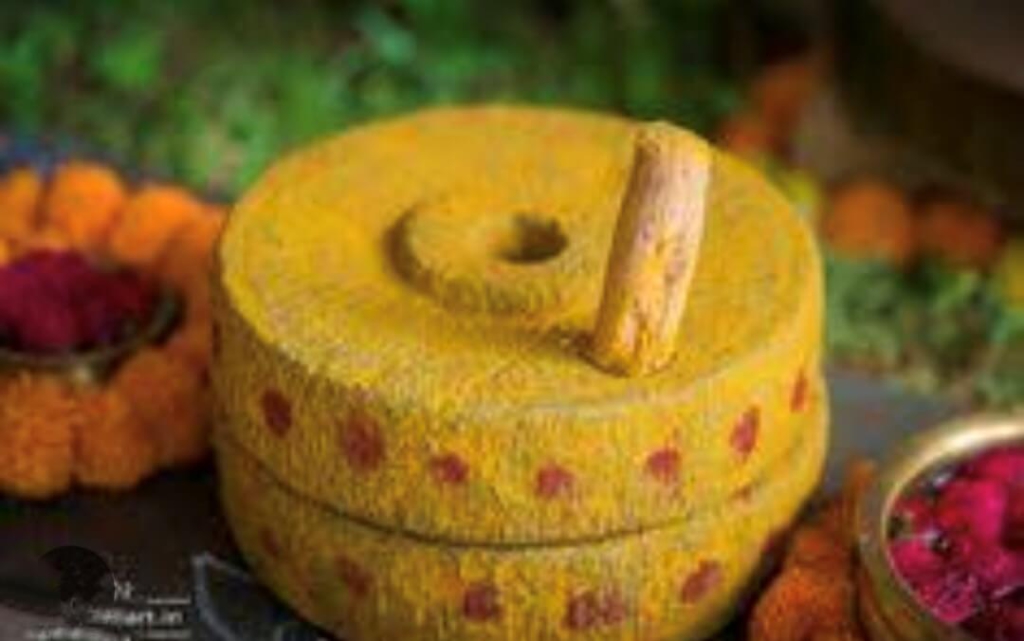
Image source: Pinterest
The stone grinder idol that was established before the wedding in Dev Sthapna ritual, is dismantled by the priest. He visits the home of the groom on the next day of the wedding and performs a small puja for this. After completion, the mother of the groom feeds the couple seven mouthfuls of rice, milk and sugar.
Check this also Marathi Wedding Rituals
Satauraah or Satawarah –

Image source: Weddingz.in
The priest tells an auspicious time according to his calculations when the bride visits her paternal home with her husband for the first time after the wedding. At her paternal home, the couple receives a grand welcome from all family members. A traditional lunch is also organized with all the close family members. While leaving the daughter and son-in-law receive too many gifts and blessings from the parents and other family members.
Check this also Tamil Wedding Rituals
Gadjani –

Image source: ShaadiWish
This ritual marks the end of a lavish Sindhi wedding event. The bride is formally introduced to every far and close relative and friend of the groom’s side. The groom’s side also hosts a reception party, where they welcome the guests with sumptuous Sindhi vegetarian food and refreshing drinks.
Check this also Telugu Wedding Rituals



